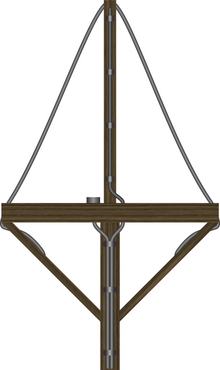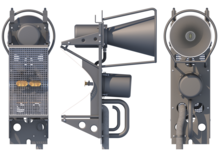Radio monitoring device

Radio measuring and monitoring device (official abbreviation: Fu MB ; often written FuMB ) is the before and during the Second World War common German name for a radar for reception of electromagnetic waves in the high frequency range. ( Such a measuring device is often called an HF scanner in New German .) They served the purpose of a radar warning device , especially on submarines .
description
The acronym stands for Fu nk m ess b eobachtungsgerät. Occasionally, a radio transmitter is used to explain the abbreviation, but this is incorrect. FuMB worked on different wavelengths and were used in the Luftwaffe and Navy in the early 1940s . After the first devices of this type covered relatively low frequency ranges, such as the VHF range (30 MHz to 300 MHz), it became necessary in the course of the war to be able to "observe" higher frequencies. For example, the Fu MB 4 (Samos) developed in 1942 , which covered 90 MHz to 470 MHz, was followed a year later by the Fu MB 5 (Fanö) for 400 MHz to 1600 MHz.
The so-called “ Rotterdam device ” had a major influence on the development of German radio monitoring devices . This is the German code name of an early February 1943 in Rotterdam downed British Stirling - Bombers . This was a brand new centimeter waves - radar from the type H2S on board, found the Germans in the wreck and extensions. The decisive component was a magnetron , which was state-of-the-art at the time , which allowed the generation of microwaves in the S-band , i.e. at 3 GHz (10 cm). This could not be detected by any existing FuMB. For this purpose, the development of the Fu MB 7 (Naxos) was pushed ahead, which was operational from autumn 1943.
Radio monitoring devices
- FuMB 1 (Metox)
- FuMB 4 (Samos)
- FuMB 5 (Fanö)
- FuMB 7 (Naxos)
- FuMB 8 (Cyprus)
- FuMB 9 (bug)
- FuMB 10 (Borkum)
- FuMB 11 (Corfu)
- FuMB 24 (fly)
- FuMB 25 (mosquito)
- FuMB 26 (Tunis)
- FuMB 35 (Athos)
- FuMB 37 (Leros).
Trivia

- Many FuMB devices were named after islands.
- One of the first FuMBs used on submarines in the Kriegsmarine was FuMB 1 (Metox). It used a temporary wooden cross (picture) with a double dipole as antenna . Because of the area of operation, the Bay of Biscay monitored by the Royal Air Force , and its appearance, it was called the " Biscay Cross ". The handling was tedious. It had to be held in the hand and then rotated in different directions. An initially open on the bridge lying cable the signal was through the turret hatch and the center of the boat in the radio room routed where the radio operator by an acoustic signal, a hum, a receiving device was informed of a performance radar tracking.
literature
- Arthur O. Bauer: Radio direction finding as an Allied weapon against German submarines 1939-1945. How weaknesses and failures in the radio control of the submarines contributed to the outcome of the “Battle of the Atlantic”. Arthur O. Bauer Selbstverlag, Diemen , The Netherlands 1997, p. 195, ISBN 3-00-002142-6 .
Web links
- "Funkmeßgerätekunde" OKM MDv. No. 291
- On-board radios of the German Air Force 1939–1945
- Manual , scan of the authentic work script of Fu MB 4 (Samos).
